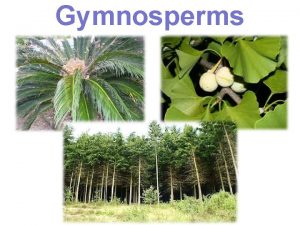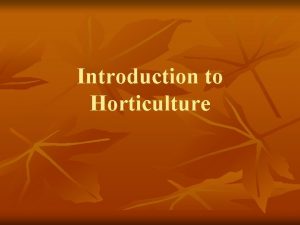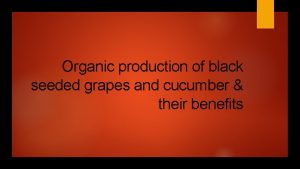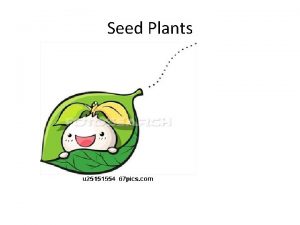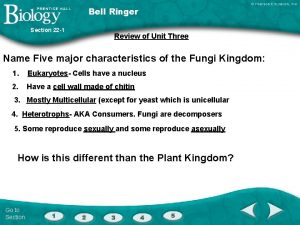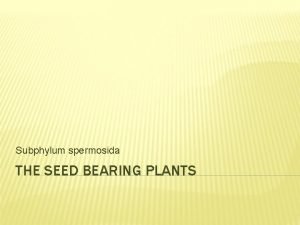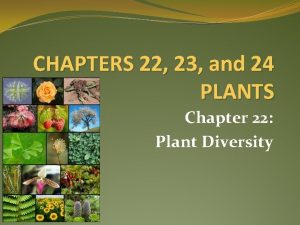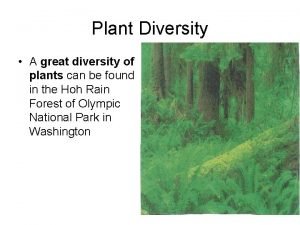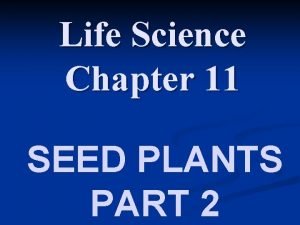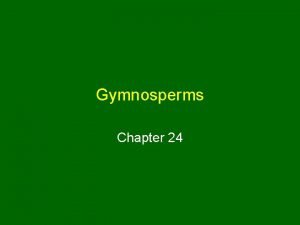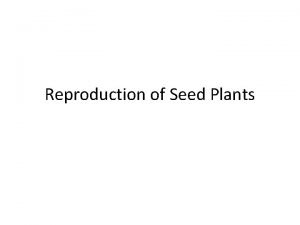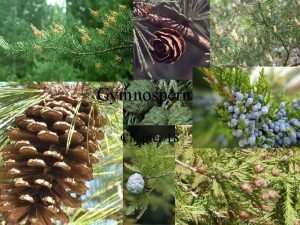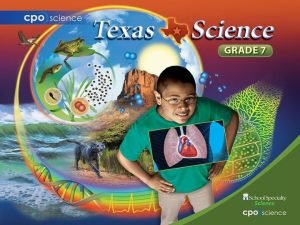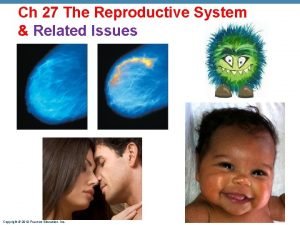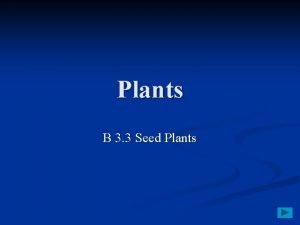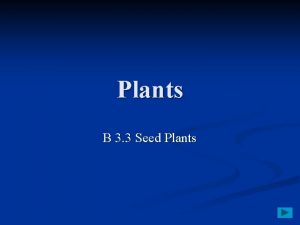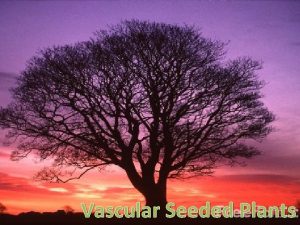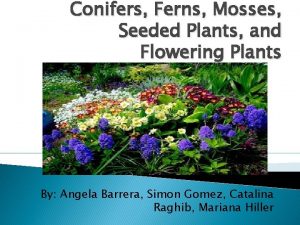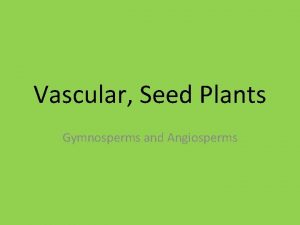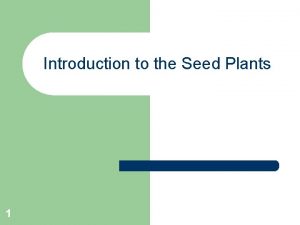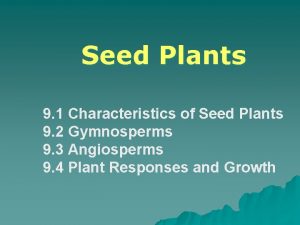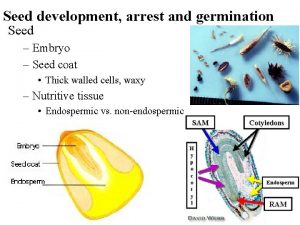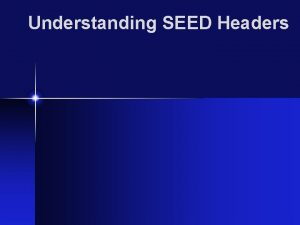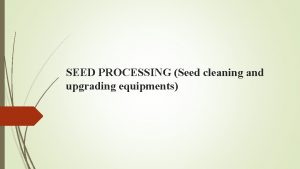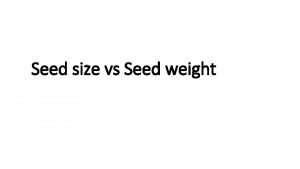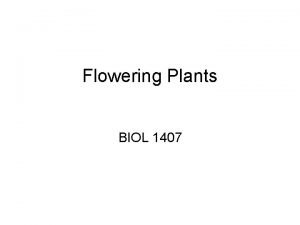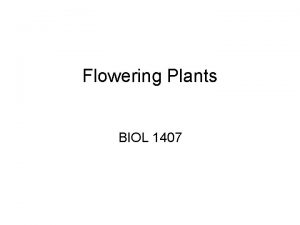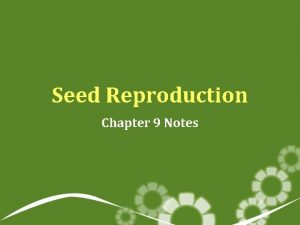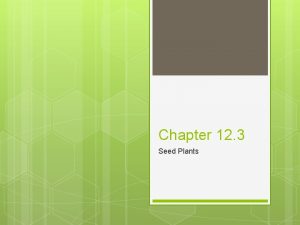Chapter 26 Seeded Plants Seed Plants aka spermatophytes




































- Slides: 36

Chapter 26 Seeded Plants

Seed Plants • aka spermatophytes • Evolved to be sporophyte dominant • Systematic reduction in gametophyte size • All are heterosporous • Megaspores (female) - develop into female gametophytes that produce eggs • Microspores (male) – develop into male gametophytes that produce sperm

Distinguish between seedless and seeded: 1. Seeds 2. Pollen These are critical adaptations for drought Also necessary for reproduction that doesn’t require water

Earliest seed plants • 350 mya • Progymnosperms – preceded gymnosperms; transitional group that superficially resembled conifers but reproduce like Bryophytes • Gymnosperms – 380 mya • Naked seed plants • Dominated in Triassic and Jurassic periods of Mesozoic era • Angiosperms • Surpassed gymnosperms in middle of the Cretaceous (~100 mya)

Today - Angiosperms are the most abundant plant group in terrestrial biomes Pollen and seeds allowed plants to break their dependence on water for reproduction and embryo development

Pollen • Pollen grains are the male gametophytes; contain sperm • Protective coat prevents desiccation and mechanical damage • Can travel far from original sporophyte – spreading genes • Male gametes reach female gametophyte and egg cell through pollen tube (extension within the pollen grain)

Seed • Protection, nourishment for embryo • Allows it to be dormant for many years • Ensuring germination when conditions are optimal • Contain diploid embryo that will germinate into a sporophyte

Evolution of Gymnosperms • Gymnosperms are 1 st true seed plants because they developed structures called cupules to enclose and protect the ovule • Ovule – female gametophyte; develops into a seed upon fertilization • Seed plants became numerous and diverse in Carboniferous period

Evolution of Angiosperms • Produce flowers containing male and reproductive structures • Diversification of angiosperms in mid Cretaceous also linked with appearance of many modern day groups of insects • It is now believed that angiosperms did not evolve from gymnosperms • Developed in parallel with gymnosperms

• Flowers and fruit are improved reproductive strategies that protect embryo while increasing genetic variation and range • Angiosperms produce their gametes in separate organs – usually in a flower • Fertilization and embryo development are protected inside • Most flowers have a mutualistic pollinator with distinctive features

• Fertilization of egg – ovule grows into a seed • Fruit – results from thickening of surrounding tissues and ovary • Fruit protects the seed and often ensures its dispersal over a wide range • Fruits vary widely: Pineapple, avocado, walnut shells, olives, tomatoes • Fruits also act as an agent of dispersal

Gymnosperms • Means “naked seeds” • Diverse group of seed plants • Paraphyletic

Characteristics of Gymnosperms • Naked seeds • Separate male and female gametes • Pollination by wind • Tracheids • Seeds NOT enclosed in ovary (exposed on cones or modified leaves)

• Sporophylls – specialized leaves that produce sporangia • Strobilus –sporophylls arranged around a central stalk (cones) • Integument – layer of sporophyte tissue surrounds megasporangium

• Gymnosperms are still the prominent phylum in the Taiga where evergreens have an advantage in cold and dry weather • One disadvantage – conifers are more susceptible to infestations because they don’t lose all of their leaves at once; can not shed parasites and restart fresh

Gymnosperm life cycle • Alternation of generations • Sporophyte dominant • Reduced gametophyte • Heterosporus • Reproductive organs form cones and strobili • Monoeclous – male and female sporangia produced on the same plant • Dioecious – male and female sporangia produced on separate plants

Modern day gymnosperms: 4 phyla • Coniferophyta • Cycadophyta • Ginkgophyta • Gnetophyta

1. Conifers (Coniferophyta) • Most variety • Tall trees, needlelike leaves • Harvested for paper pulp and timber

2. Cycads (Cycadophyta) • Mild climates • Mistaken for palms • Large cones • Some pollinated by beetles (rather than wind) • Only ~ 100 species still living

3. Gingkophytes • Single surviving species Gingko biloba • Fan shaped leaves • Unusually resistant to pollution

4. Gnetophyta • Closest relative to angiosperms • Broad leaves • Varied from tropical rainforests to desert environments • Ephedra – source of ephedrine (powerful decongestant)

Angiosperms • Flowering plants • Dominate most terrestrial ecosystems • > 250, 000 species • Success is due to flowers and fruit

Flowers • Modified leaves (sporophylls) • Sepals – together called calyx; base of peduncle, enclose the unopened floral bud • Petals – together called corolla; inside whorl of sepals; vivid colors to attract pollinators • Sepals + petals = perianth

• Sexual organs located at center of flower • Female reproductive organs: Gyoecium (carpel) – consist of style, stigma and ovule • Flower structure is diverse • Pistil – multiple fused carpels • Megaspore and female gametophytes are produced and protected by thick tissues of carpel

• Style – long, thin structure leads from stigma to ovary • Stigma – pollen is deposited • Ovary – enclosed in carpel; houses 1 or more ovules • Ovules will develop into a seed when fertilized

• Male reproductive organs – Androecium (stamen) • Surround the central carpel • Filament – thin stalk • Anther – sac like structure; supported by filament; where microspores are produced through meiosis and develop into pollen grains

Fruit • As seed develops, ovary walls thicken and form fruit • Seed forms in an ovary which also enlarges as seed grows • Fruit – fertilized and fully grown ripened ovary • Fruits contain seeds: eggplant, zucchini, string beans, peppers • Mature fruits can be fleshy or dry • Fleshy – berries, peaches, apples • Dry – rice, wheat, nuts

Angiosperm Life Cycle • Sporophyte dominant • Heterosporous (micro and megaspores) • Double fertilization • 1 sperm – joins with egg and forms diploid zygote (future embryo) • 2 nd sperm – fuses with polar nuclei forming triploid cell; develops into endosperm which serves as a food reserve

2 major groups of angiosperms • Monocots – contain 1 leaflike cotyledon • Dicots – contain 2 cotyledons • Seed food is stored outside embryo in the form of a complex carbs, lipids and proteins • Cotyledons are embryonic leaves that transport broken down food reserves from their storage site inside the seed to developing embryo

• Most flowers are monoecious (bisexual) – both stamen and carpel • But only a few species self-pollinate • These flowers also contain both types of sex organs • Cross pollination increases genetic diversity in a species

Diversity of Angiosperms • Phylum – Anthophyta • Monophyletic • 2 major groups: • Moncots • Dicots (aka eudicots)

Monocots • Single cotyledon • Parallel leaf veins • Adventitious roots • Ex. Palms, rice, corn, bananas

Eudicots • 2 cotyledons • Branched leaf veins • Herbaceous or woody • Taproot • Ex:

Role of seed plants • Herbivory – consumption of plants by insects and other animals • Co-evolution of flowering plants and insects

Pollination • Wind, water, animals • > 80% angiosperms depend on animals for pollination • Nectar – sugary liquid secreted by many animal-pollinated flowers • Fertile pollen (for reproduction) • Sterile pollen (nutrients for pollinators)

Importance of seed plants for Humans • Crops - rice, wheat, potatoes • Perfume • Alcohol • Timber • Fuel • Paper • Clothing • Dyes • Medicine
 Gingkophytes
Gingkophytes Seed producing vascular plants
Seed producing vascular plants Importance of spermatophytes
Importance of spermatophytes Turf areas in xeriscaping designs should be seeded in
Turf areas in xeriscaping designs should be seeded in Organic seeded grapes
Organic seeded grapes Road katy
Road katy Anna easter brown
Anna easter brown Seed plants are divided into two groups
Seed plants are divided into two groups Genesis all seed bearing plants
Genesis all seed bearing plants Section 22-4 seed plants answer key
Section 22-4 seed plants answer key Life cycle of seed bearing plants
Life cycle of seed bearing plants Section 22-4 seed plants
Section 22-4 seed plants Parts of a seeds
Parts of a seeds Cooksonia
Cooksonia Lesson 11: seed plants
Lesson 11: seed plants Why are gymnosperm seeds referred to as “naked seeds”?
Why are gymnosperm seeds referred to as “naked seeds”? Flower ovule
Flower ovule Microstrobili and megastrobili
Microstrobili and megastrobili Lesson 11 seed plants
Lesson 11 seed plants Nonvascular plants definition
Nonvascular plants definition Vascular plants vs nonvascular plants
Vascular plants vs nonvascular plants Non flowering plants classification
Non flowering plants classification C3 plants vs c4 plants
C3 plants vs c4 plants Zabranjena vrata prezentacija
Zabranjena vrata prezentacija Shakespear aka the bard of
Shakespear aka the bard of Pyramids of passion
Pyramids of passion Akacatholic
Akacatholic Geneva monitoring
Geneva monitoring How to write a letter of interest for aka
How to write a letter of interest for aka I3on
I3on Httpaka.ms/remoteconnect
Httpaka.ms/remoteconnect Aka.msm
Aka.msm Httpsaka
Httpsaka Aka captions
Aka captions Aka sustentacular cells
Aka sustentacular cells Aka sigma epsilon omega
Aka sigma epsilon omega åka skidor tjeckien
åka skidor tjeckien

